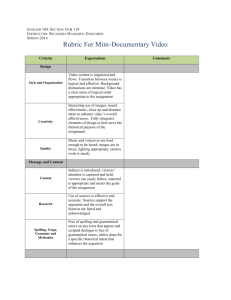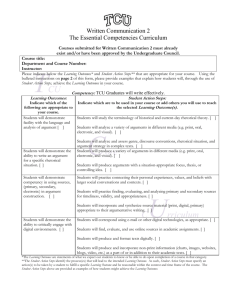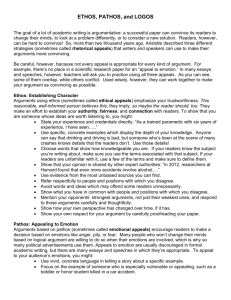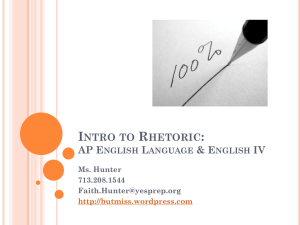chapter 5
advertisement
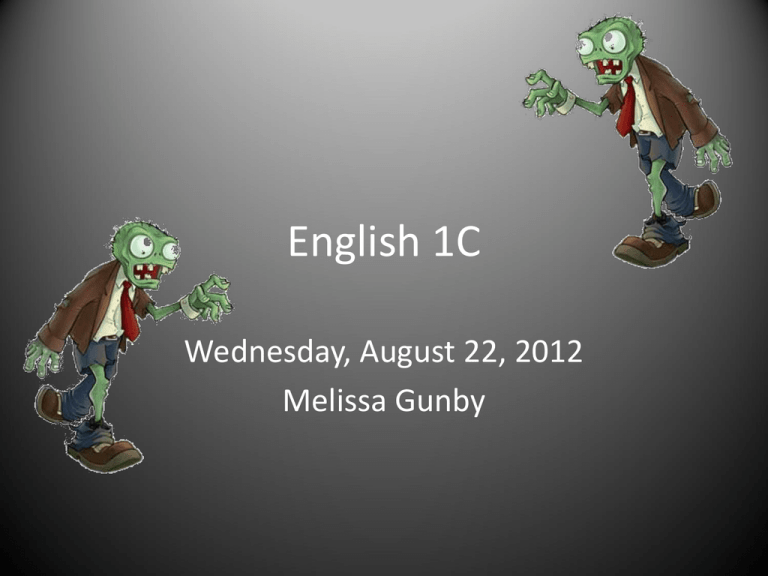
English 1C Wednesday, August 22, 2012 Melissa Gunby Rhetorical Analysis CHAPTER 5 What is Rhetorical Analysis? • Rhetorical analysis is to perform a close reading of a text to find how and whether it works to persuade the intended audience. Composing a Rhetorical Analysis • • • • • • • • • Purpose Audience Appeals Type of argument Author Appeals to Authority Facts/Logic/Evidence Context Language Purpose • To understand how well an argument works, you have to know what its purpose is. To sell shoes? Advocate for Social Security reform? • Purpose isn’t always self evident; have you ever taken a telephone survey that turned out to be trying to get you to change your long distance service? Understanding Who Makes an Argument • Knowing who is claiming what is the key to any rhetorical analysis. • Remember “I’m George W. Bush and I approved this message” from the last campaign? Federal law now requires disclosure so that viewers know what ads are paid for by candidates and which are paid for by lobbying groups or PACs. • Sometimes analysis requires deeper digging than just knowing the author’s name. Funny, offensive, or both? Does this bumper sticker have a different interpretation upon deciding who the author is? Why or why not? Audience • Most arguments are composed with a specific audience in mind. • Consider Wal-Mart. How do they appeal to the following audiences: – Single parents – Lower-income households – College students Readers and writers in context writer Readers existing in writer’s mind: intended/ideal readers text Readers represented in the text: invoked readers readers Readers as they actually exist: real readers Mission and Vision Latino culture College culture Mainstream culture Pathos: Playing on Emotions • We’ve already talked about pathos, or appealing to emotions. • None of us are really fooled by ads that portray a fantastic life if we drink one brand of soda over another, yet that’s how advertisers work. • Your task in performing a rhetorical analysis is to study the author’s words, the emotions they evoke, and the claims they support and then make a judgment about the effectiveness. Pathos How is this ad more effective than simply saying “don’t drink and drive” and why? What about the one below? Ethos: Arguments based on Character • We’ve already talked about ethos, and its role in establishing the credibility of the author for the audience. • When conducting a rhetorical analysis, pay specific attention to the details, right down to the choice of words, or colors and shapes. • Things to consider: are the claims qualified reasonably? Does the author have authority or experience? Is the evidence presented in full? Are the objections noted? Are sources documented? Does the writer sound trustworthy? Logos: Fact and/or Logic and Reasoning • When analyzing arguments, you’ll have to decide whether the argument makes a plausible claim, and then, whether or not you agree/believe it. • Not all arguments will have an explicit thesis. • Look for how the claims are supported by good reasons and reliable evidence. Longer arguments may have a series of claims. • In a rhetorical analysis, identify all the separate propositions/claims and examine the relationship(s) between them. Examining the Arrangement and Media of Arguments • Arguments have a structure just like essays and human anatomy. • Aristotle narrowed it down to two parts – Statement – Proof • Despite that structure, there is not formula or patterns that fit all arguments. • When writing a rhetorical analysis, you have to assess the organization of a piece based on how it is effective, or not, overall. What to look for • Things that are missing – Editorials about a new sports stadium that don’t address feasibility questions – Movie reviews that don’t reveal criteria • Transitions, headings, subheadings, documentation sources, tone of voice • Use of media – Does a spoken argument translate to print or vice versa? Are the images necessary or distracting? • Non-traditional structures Style • Even a coherent argument can be disconnected from the readers if it lacks an element of style. • In a rhetorical analysis, you can explore many different styles. Why does a formal style work better for one subject rather than another? Topic/Message (logical appeals) Rhetorical Triangle It’s important to read any rhetorical situation as dynamic, since each element has the potential to affect all the other elements. A change in audience, for example, can lead you to reconsider all of your appeals. You’ll find yourself habitually viewing any topic from a number of perspectives and hence develop greater critical engagement with the issues and ideas important to you. Such a rhetorical fame of mind might even lead you to challenge the title of this textbook: is everything really an argument? Audience/Readers (Emotional Appeals) CONTEXT Speaker/Writer (Ethical Appeals) Visual Arguments CHAPTER 14 What argument does this visual make? The Power of Visual Arguments • We don’t need to be reminded that visual arguments have power. What are some vivid images that are embedded in your memory? Influence • Images are influential; think about all the ways that we encounter images in our daily lives. • Today, we’re used to being bombarded with visual documentation, from the internet to television to magazines. Shaping the message • Images make arguments of their own. • A photograph isn’t a faithful representation of reality; it’s reality shaped by the photographer's point of view. • Those who produce the images shape the messages that those images convey, but the “readers” aren’t passive either; human vision is selective. • People don’t se things the same way Analyzing Visual Elements of Arguments This ad was created by the Campaign for Tobacco-Free kids. They work together with the Academy of General Dentistry and American Federation of Teachers, with the Church of Jesus Christ of Latter-Day Saints and the Sierra club. Whose view of big tobacco does the image represent? Questions to Ask: Some of the following questions can be great guidelines to consider as you encounter visuals. About the Creators and Distributors • Who created this visual text? Who distributed it? • What can you find out about these people and other work that they have done? • What does the creator’s attitude seem to be toward the image? • What do the creator and the distributor intent dis effects to be? Do they have the same intentions? About the Medium • Which media are used for this visual text? Images only? Words and images? Sound, video, graphs, or charts? • How are the media used to communicate words and images/ How do various media work together? • What effect does the medium have on the message of the visual text? How would the message be altered if different media were used? What role is played by the words that accompany the visual text? How do they clarify, reinforce, blur or contract the images' message? About Viewers and Readers • What does the visual text assume about its viewers and about what they know and agree with? • What overall impression does the visual text create in you? • What positive or negative feelings about individuals, scenes, or ideas does the visual intend to evoke in viewers? About Content and Purpose • What argumentative purpose does the visual text convey? What is it designed to convey? • What cultural values does the visual evoke? The good life? Love and harmony? Sex appeal? Youth? Adventure? Economic power or dominance? Freedom? Does the visual reinforce these values or question them? What does the visual do to strength the argument? • What emotions does the visual evoke? Are these the emotions that it intends to evoke? About Design • How is the visual text composed? What’s your eye drawn to fist? Why? • What’s in the foreground? In the background? What’s in or out of focus? What’s moving? What’s placed high, and what’s placed low? What’s to the left, center, and right. What effect do the placements have on the message? • Is any information highlighted or stressed? More design • How are light and color used? What effects are they intended to have? Video? Sound? • What details are included or emphasized? What’s left out or deemphasized? • Is anything surprising about the visual text? • Is anything repeated, intensified, or exaggerated? • How are you directed to move within the argument? Using Visuals in Your Own Arguments • Pages 451-463 • I’m just going to go through these quickly, since we will mostly be working with written arguments in this class (and if we do visuals, we’ll come back and review this). Look at question number 2 at the end of chapter 14 (page 464). In groups of four, please complete this activity. You do not need to turn in a written paper, but be prepared to share your analysis with the class. ACTIVITY! Homework • Dbd: Proverbial Beans (ch 6) Nuclear Winter (ch 7), Ground Zero (ch 8), Tower (ch 9) • GZ: "The E-Dead" pg 194-205 – 1 page response. This one page my discuss part or all of the readings. • Please bring a magazine to class on Monday
